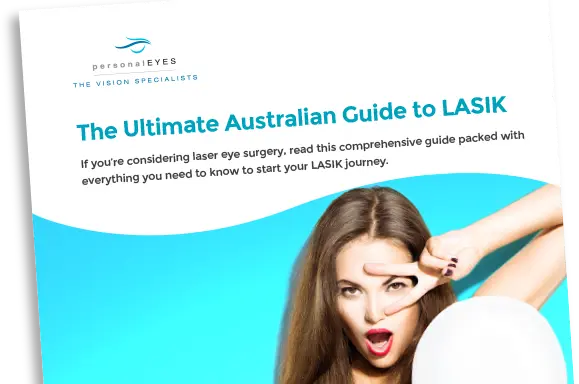Q1: Is LASIK safe?
This is a commonly-asked question and for good reason. Like all surgical procedures, there are potential risks, limitations and side effects that you should be fully aware of before undergoing LASIK surgery. LASIK surgery has an excellent safety record and a very high success rate.
Since its introduction in 1991, there have been over 10 million LASIK operations performed in Australia.
It is widely agreed that LASIK has become one of the safest, quickest and most predictable procedures for vision correction.

In a recent study done by FDA on a specific LASIK technology, 98.4%* of patients who had had LASIK done said they were very satisfied with the surgery.

30% of patients had vision outperforming the current glasses and contact lenses.

Nearly 100% of all patients would have met the Australian legal driving requirements.
Choosing the right surgeon and technology is the key to successful surgery. After deciding on your specialist, the next most important step is to make sure you are suitable for the surgery itself.
Q2: How do you know if you’re suitable for LASIK?
Unfortunately, not everyone is suitable for LASIK. The first step to determine if you are a suitable candidate for LASIK is to have your eyes checked a laser vision correction clinic.
The clinic will perform multiple diagnostic scans on your eyes to determine your suitability for LASIK surgery. These scans are painless and do not involve any contact with your eye. The scans aim to determine:
- the shape and thickness of your cornea
- the number of refractive errors present
- pupil size
- how dry your eyes are
Your general wellbeing will also be considered as this will also play a big part in your healing process.
If the diagnostic findings determine that you have a cornea which is too thin or irregular, overly-large pupils, or even refractive errors which are out of the range of correction, you will not be a suitable candidate for LASIK.
Other health conditions which could disqualify you from LASIK include:
- Your age. Most eye surgeons agree that LASIK surgery is ideal for people over the age of 20 years with a stable prescription. You need to be at least 18 years of age to qualify.
- If you are pregnant. Because hormonal changes during pregnancy can affect your eyes, many surgeons recommend waiting after the baby is born and only after you have stopped breastfeeding.
- If your prescription has recently changed. You need to have had a stable prescription for the past 12 months.
- If you experience Dry Eye Syndrome. Individuals suffering from severe dry eye syndrome may have to seek treatment before LASIK, as LASIK in some cases decrease in tear production which can cause eye discomfort and blurred vision
- Other health or eye conditions. These will affect your healing after the surgery.
Q3: What if you’re not suitable for LASIK?
Even if you are not a suitable candidate for LASIK, there are several technologies which you might still be able to have, such as PRK, implantable lenses, or even lens exchange. These can all be discussed with your laser vision correction clinic.
Q4: Is LASIK painful?
In most cases, LASIK does not hurt during, or immediately after the procedure. Before your LASIK eye surgery begins, numbing eye drops are used to control any pain or discomfort to the eye during the procedure. Patients report feeling some pressure on their eyes or a scratchy sensation. Some patients experience mild discomfort for a few days after the procedure.
Q5: Can you blink, sneeze or move during LASIK?
You do not have to worry about holding your eye open during the procedure. Numbing eye drops ensure you don’t feel the urge to blink, and a small device is used to gently keep it open when necessary.
Importantly, the laser uses a sophisticated tracking system that measures the position of your eye a thousand times per second, ensuring it is only functioning when on target, so there is no danger from blinking, sneezing or moving during the procedure.
Q6: How long does LASIK take?
The whole LASIK procedure usually takes less than 10 minutes per eye. Depending on your prescription, and the amount of correction needed, the laser itself only takes 10 seconds per eye to correct your vision. However, you should plan on being in the clinic for a few hours on your day of the procedure.
Q7: Are you awake during LASIK?
Yes. LASIK surgery usually takes less than 10 minutes per eye and does not require general anaesthesia. If you fear you will be anxious during the procedure, your LASIK surgeon can give you a mild sedative or other medication prior to surgery to help you relax.
Q8: Is LASIK permanent?
Yes, in most cases, the results achieved with LASIK are indeed permanent. Laser eye surgery doesn't protect your eyes from the effects of ageing. Those entering their mid-40s may require reading glasses, irrespective of having had LASIK or not. For patients over 40, the surgeon will discuss monovision to avoid reading glasses.
Q9: Can you see immediately after LASIK?
Your eyes start healing immediately after your LASIK surgery, and the initial healing usually occurs rapidly. However, it's normal to experience some blurred vision and fluctuations in your vision for several weeks or even months after LASIK. In most cases, vision should be stable and clear at the six-month post-op visit.
Q10: What conditions can LASIK treat?
LASIK is commonly used in the treatment of Hyperopia (Long-sightedness), Myopia (Short-sightedness), and Astigmatism.
Q11: Can Laser Eye Surgery get rid of my reading glasses?
Yes. Monovision can give you independence from reading glasses. The concept of monovision involves correcting one eye so that it is focused on reading. Monovision is subject to individual adaption and may not be suitable for everyone. Suitability for monovision can be discussed and even trialled at the time of your consultation. You may also be found suitable for multifocal lens technology - another option for reducing dependence on reading glasses.
Q12: How soon can I drive after having LASIK eye surgery?
Most people can resume driving the next day, although generally, we would recommend not driving for a day or two after surgery.
![]()










